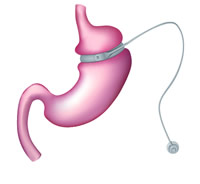Gastric Band Surgery
Adjustable gastric band surgery has become the world’s leading minimally invasive surgical procedure for the treatment of obesity, with an established safety record gained over many years.

The latest generation of adjustable gastric band surgeries deliver a safe and highly effective means of helping patients reduce their food intake and adopt a healthier lifestyle.
The gastric band surgery consists of an inflatable silicone band that is surgically placed around the upper part of the stomach. The new, small upper stomach pouch limits the amount of food that can be consumed at one time and a narrowed stomach outlet increases the time it takes for the stomach to empty so the patient feels full on very small portions. The band also stimulates the satiety messages to the brain that tell you that you feel full. The reduction in food intake results in weight-loss.
How is the gastric band inserted?
A small access port is then placed under the skin and is attached to the gastric band via a length of silicone tubing. This port is essential to allow the band to be ‘adjusted’ at a later stage.
It is expected that the patient will have their gastric band for life although it can be removed at any time. The procedure can either be done as a day case or you may require an overnight stay in hospital.
How is the band adjusted?
Your surgeon, or another qualified specialist, will insert a fine needle into the access port and inject liquid (saline) into the gastric band. This inflates the soft inner surface of the band, effectively resulting in a tightening of the band.
Your band will be adjusted little by little over a period of months, until such time as optimal level of restriction has been reached. In this so-called ‘green zone’ the patient’s food intake is restricted enough to allow optimum weight loss but is at a level where they are still getting the vitamins and nutrients required to stay healthy. The level of restriction required will vary from one person to another. Therefore, a key advantage of the gastric band is the ability to make very accurate adjustments tailored to your individual needs.
The gastric band is, however, only part of the solution. It can not work without your commitment to change your eating habits and adopt a healthier lifestyle. You won’t be on your own however – our professional healthcare team will support you throughout your journey providing you with help and advice at every stage.
Benefits of gastric band surgery
- Proven to aid weight-loss
- Adjustable to suit each individual patient
- No stomach stapling or cutting or intestinal re-routing
- Placed using keyhole surgery leaving minimal scarring
- Does not require patients to take food supplements
- Fully reversible
- Many years’ worldwide experience
- Helps create and maintain a feeling of fullness
- Makes it easier to adopt changes to your eating habits and lifestyle
To qualify for gastric band surgery you must have tried to lose weight using conventional methods without success and be:
- At least 18 years old
- Overweight with a Body Mass Index (BMI) above 40
- Overweight with a Body Mass Index (BMI) of 35 or above and suffer from an obesity-related health condition that poses a serious risk to your long term health (e.g. diabetes, high blood pressure, heart disease, etc)
- Ready to commit to long-term changes relating to eating patterns and exercise
- Willing to have band adjustments in order for the band to reach its optimum effectiveness
- Gastric banding is best suited to a person who has regular meal patterns and whose diet does not include a lot of sweet foods.
How much weight could I expect to lose?
To learn more about this gastric band surgery contact us on 01753 665480.





